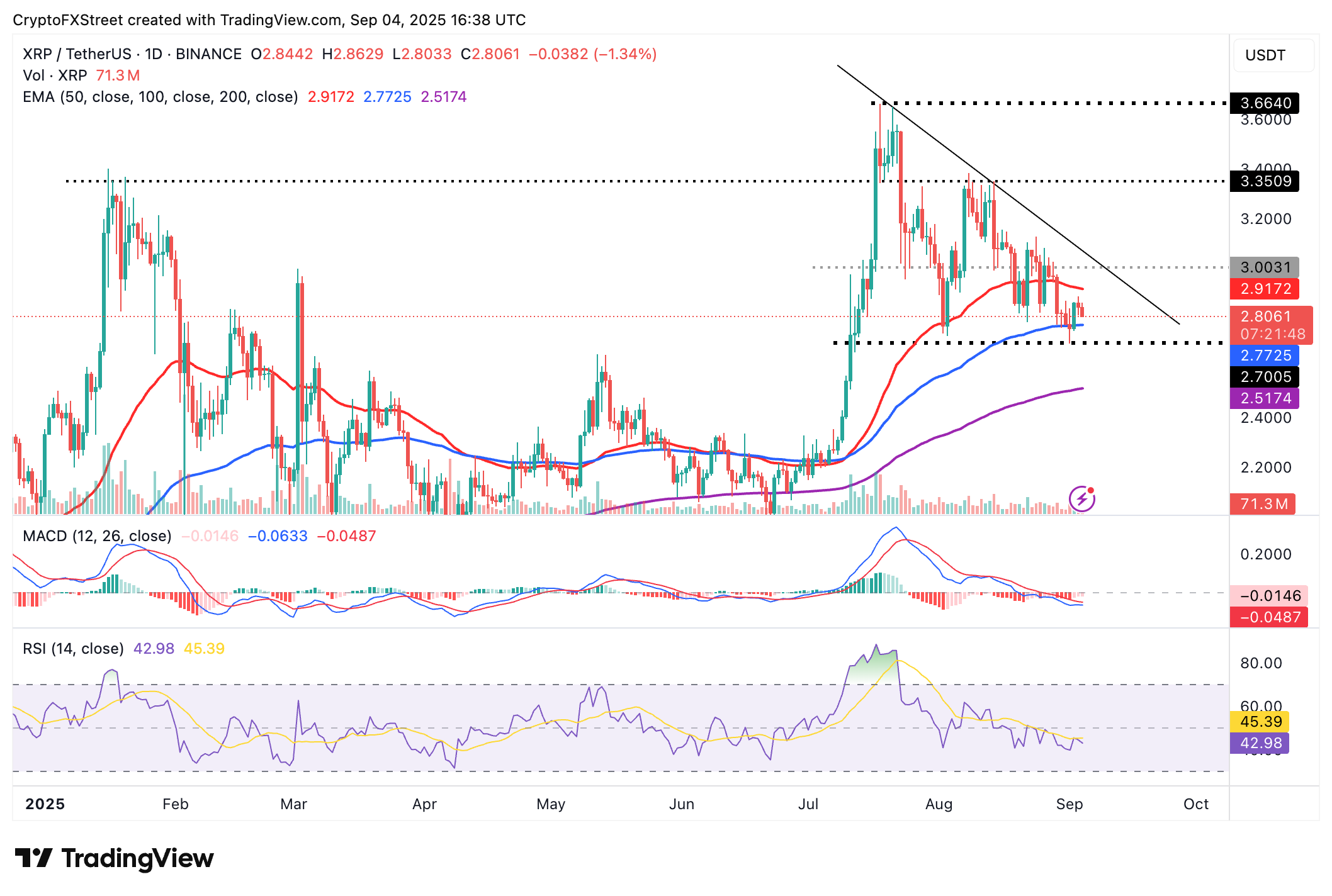Ripple Price Forecast: XRP bearish bias extends as whales de-risk
- XRP price eyes fresh monthly lows toward the 200-day EMA support.
- Whales holding between 10M and 100M XRP reduce exposure as the price wobbles.
- Active addresses slump 54% from July peak levels amid low on-chain activity.
Ripple (XRP) remains range-bound, fluctuating between the demand zone at $2.77 and the supply area at $3.00 on Thursday. An attempt to breach the resistance lost momentum on Wednesday, leaving XRP vulnerable to retail and institutional selling, as well as low on-chain activity.
XRP faces mounting selling pressure with low on-chain activity
Interest in XRP has consistently dropped since its local top of $3.66 reached on July 18. The derivatives market reflects the low demand with the futures Open Interest (OI) falling to $7.56 billion after peaking at $10.94 billion on July 22.
Large volume holders have also been de-risking, possibly taking profits as XRP sustains a weak technical structure.
Santiment data shows that wallets with between 10 million and 100 million XRP are aggressively selling, reducing their holdings to 11.88% of the total supply from 13.12% recorded on July 27.
If aggressive selling persists, it will become increasingly difficult for XRP to sustain its recovery in the short term.
 [18-1757004597521-1757004597521.42.03, 04 Sep, 2025].png)
XRP Supply Distribution | Source: Santiment
On-chain activity on the XRP Ledger (XRPL) has also slowed significantly over the past few weeks. CryptoQuant data indicates a 54% decline in active addresses, from approximately 50,000 on July 18 to around 23,000 on Wednesday.
The sharp drop indicates a decline in user engagement and transaction activity on the protocol. In other words, XRP is facing declining adoption and user interest, resulting in low demand.
If the trend is sustained, reduced confidence in the token's ability to hold its value or recover could take center stage. Still, temporary dips tend to be normal, paving the way for new entry opportunities and a stronger rebound in the price.
-1757004566788-1757004566788.png)
XRP Active Addresses | Source: CryptoQuant
Technical outlook: XRP poised for further decline
XRP price is edging closer to the 100-day Exponential Moving Average (EMA) at $2.77 as overhead pressure intensifies. The Moving Average Convergence Divergence (MACD) indicator has maintained a sell signal since July 25, underscoring the bearish bias.

XRP/USDT daily chart
The Relative Strength Index's (RSI) gradual decline to 42 mirrors the bearish market sentiment, stemming from whales' selling and low on-chain activity. If the RSI prolongs the downtrend into oversold territory, bearish momentum will intensify, increasing the likelihood of XRP falling to test the 200-day EMA support at $2.51.
Ripple FAQs
Ripple is a payments company that specializes in cross-border remittance. The company does this by leveraging blockchain technology. RippleNet is a network used for payments transfer created by Ripple Labs Inc. and is open to financial institutions worldwide. The company also leverages the XRP token.
XRP is the native token of the decentralized blockchain XRPLedger. The token is used by Ripple Labs to facilitate transactions on the XRPLedger, helping financial institutions transfer value in a borderless manner. XRP therefore facilitates trustless and instant payments on the XRPLedger chain, helping financial firms save on the cost of transacting worldwide.
XRPLedger is based on a distributed ledger technology and the blockchain using XRP to power transactions. The ledger is different from other blockchains as it has a built-in inflammatory protocol that helps fight spam and distributed denial-of-service (DDOS) attacks. The XRPL is maintained by a peer-to-peer network known as the global XRP Ledger community.
XRP uses the interledger standard. This is a blockchain protocol that aids payments across different networks. For instance, XRP’s blockchain can connect the ledgers of two or more banks. This effectively removes intermediaries and the need for centralization in the system. XRP acts as the native token of the XRPLedger blockchain engineered by Jed McCaleb, Arthur Britto and David Schwartz.

